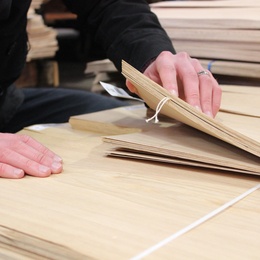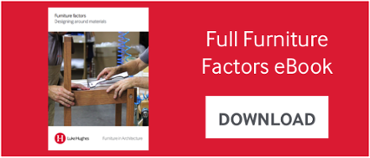When deciding whether to use solid timber or wood veneers for your furniture project, you should consider appearance, life expectancy, cost and budget. Read on for our top tips on how to strike a balance ...
Please note: this information is based on the experience of Luke Hughes; it is not intended to be the final word.
Appearance
In your design project, the pattern variety of the veneers are only limited by the ingenuity of the designer and the craftsman. Veneered tops are more likely to match in colour and consistency of figure; they are less likely to warp or move with humidity changes; the potential width of the leaves is greater; interesting patterns can be achieved using the veneer-matching techniques described above or by bordering veneered panels with solid edges and inlays.
Solid timber has a more lustrous, substantial feel but is less predictable in figure and more awkward to match in patterns.
If the table is large or in several sections and it is important that each table section matches precisely, there is little viable alternative than to use veneers.
Life expectancy
Boardroom tables are rarely used for more than 12-15 years (the average length of commercial office leases) so different criteria apply from institutional buildings (for example, churches, colleges or museums) which enjoy conditions where the intended life might be 50-100 years; there is no reason why solid tables should not last for centuries.
Veneered tops are difficult to repair inconspicuously (damage to the centre of a large table can be an irritating blemish); solid timber is by contrast usually straightforward to patch or repair and often acquires attractive patina with scars.
Solid timber is essential for areas susceptible to impact (such as table edges, corners of legs, door handles and shelf lappings) but it is important not to make solid sections so wide that the distortions open up mitres or show traces of shrinkage under the veneer (a feature known as ‘telegraphing’).
Most damage to furniture occurs when it is moved so it is important that all areas that are handled or liable to being knocked are made using solid sections.
Areas where there is much use of food and alcohol and where tables are liable to need repolishing regularly (say, every five years) are much better made with solid tops; veneers will wear through quickly when stripped.
Cost and budget
Sometimes the labour cost of lipping and veneering can exceed the cost of working in solid timber; it requires detailed knowledge and a judicious mix of materials and techniques to get the most economic solution.
Comparative costs of typical veneers and oak can be found in our eBook 'Furniture factors: Designing around materials'. Click below to download.
Enjoy the article? Delve deeper into Luke Hughes & Company’s place in the Arts and Crafts tradition with the fascinating new book 'Furniture in Architecture' . Available through Thames & Hudson






